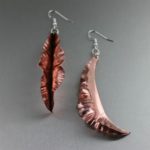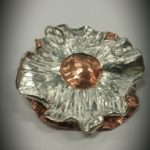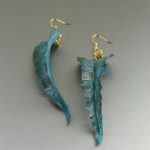Fold forming is one of the most beautiful ways to sculpt metal into graceful shapes. This technique gives you the ability to transform flat metal into flowing, three dimensional shapes that have a natural, organic quality to them. The finished pieces are lightweight, which makes them easy to wear. And you don’t need a lot of tools to create some of the loveliest jewellery you will ever see.
The basics for fold forming are 26-30 gauge sheet metal, a hammer, a bench block, a torch, and a fire brick. The metal can be sterling silver, copper, brass or bronze and needs to be dead soft. A heavier gauge can be challenging to work work with if you’ve never done fold forming before. Riveting hammers work very well for fold forming, although other types of hammers and other objects can also be used for different textures and different effects. The bench block provides the hard surface to hammer on. And of course, if you have a torch, you need a fire brick! For fold forming, any kind of torch will do, although a butane torch will supply sufficient heat for annealing.
To start, determine the finished size of your piece. If you want to make a leaf-shaped piece, use the measurements for the longest and widest parts of the leaf as a guide for cutting your metal. You do not need to cut the leaf shape to begin with – that can be done after you have finished your hammering. Cut the metal according to your measurements and fold in half using pliers and your fingers. Place the metal on the bench block and start hammering gently along the open edges with the narrow end of a rivet hammer. The idea is to stretch the metal
to create a “ruffle ” effect.

The more the metal is hammered, the more it will stretch. The metal needs to be annealed periodically, as the hammering will work harden it and cause it to become brittle. Make sure to flip the metal and hammer on both sides equally. Continue to hammer and anneal until you are satisfied with the results. At this point, while the metal is still folded, you can draw the shape of half a leaf on the metal, with the middle of the leaf being on the fold. Saw along the line through both layers of metal. You can now do some more hammering along the edges while the metal is still folded. You will need to anneal the metal again before unfolding it, using pliers and your fingers. Pickle and rinse. File and/or use silicone discs to smooth the sharp edges. Drill holes for hanging your pieces from ear wires or jump rings and smooth off the drill bit bur.
Patina brings out the texture on silver fold formed pieces beautifully and gives them nice depth. You can use a blackener and polish the areas that you would like to remain shiny. You could also paint on liver of sulfur gel, rinsing the pieces in extremely hot water to get some amazing colours. For a subtler effect, stir some liver of sulfur into hot water and immerse your pieces. This gives more of an antiqued look. On copper, try using your torch to “heat paint” your pieces.

You can also create a verdigris finish on COPPER using salt and ammonia. If you are using chemicals of any kind, please make sure to use them in a well-ventilated area. Don’t forget to tie long hair back, (bangs out of your eyes, too!) and wear your safety goggles. I also like to wear a mask when I am using the silicone discs and bullets as they can produce a lot of particulates that I don’t care to breathe in!
You can embellish your fold formed pieces with stones. The easiest way is to solder a bezel cup onto a flat area of the form and set the stone you’ve selected. Don’t forget that patinas can affect a lot of stones adversely, so setting is the last thing to be done.
I think that Spring is the perfect time of year to be inspired by the new leaves and flowers bursting forth, but you can find inspiration in many natural forms. There are also many wonderful books and likely hundreds of photos online of stunning fold formed pieces. Wherever you get your inspirations from, no two fold formed pieces are ever exactly the same, so wear them knowing that much like you, they are originals!
Have fun creating beautiful jewellery pieces with this wonderfully organic technique!
